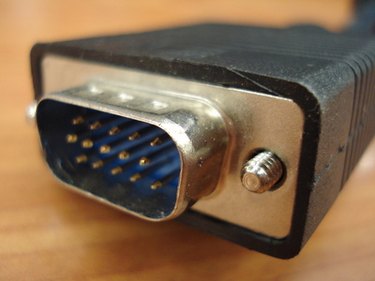
Most computers, including laptops, feature a VGA port. If your VGA port breaks, you will need to find another way of interfacing your computer with your primary display. According to the ports available on your computer, you can interface your computer with another display via an alternate video port on your computer. You may also purchase and set up an external video adapter through an available USB or PC Card slot. If you have a desktop computer and your VGA port is broken, swapping the broken video card for a new one is likely your best choice.
Step 1
Examine the computer's additional ports. Check your computer specifications or computer manufacturer's support documentation. Make note of the following specific video outputs: DVI (Digital Visual Interface), HDMI (High-Definition Multimedia Interface) and S-Video. Also note any USB, FireWire or PC Card/ExpressCard slots.
Video of the Day
Step 2
Purchase a connector cable if you have an alternate video output, such as DVI, HDMI or S-Video. The display you connect to must have a slot other than "VGA In." DVI and HDMI are common on newer high-definition televisions and monitors, while you can find S-Video on many older televisions. Connect your PC's alternate video output port with the corresponding input port on the display.
Step 3
Research and purchase an external video adapter that works on an available slot, if VGA is the only video output available on your laptop. USB-based video adapters are the most popular and convenient for most computer owners since nearly all computers feature at least one USB port. You can also find PC Card adapters. Install the external video adapter by interfacing it with the correct port on your computer. Windows will give you a message saying it has Detected new hardware. Install any additional software that ships with the device.
Step 4
Consider replacing the internal video card with another internal card if you have a desktop computer. Research your motherboard and learn what slot types are available. Common video card slots are AGP, PCI and PCI Express. You must open the case, remove the old card and insert the new card in order to perform this task.
Video of the Day